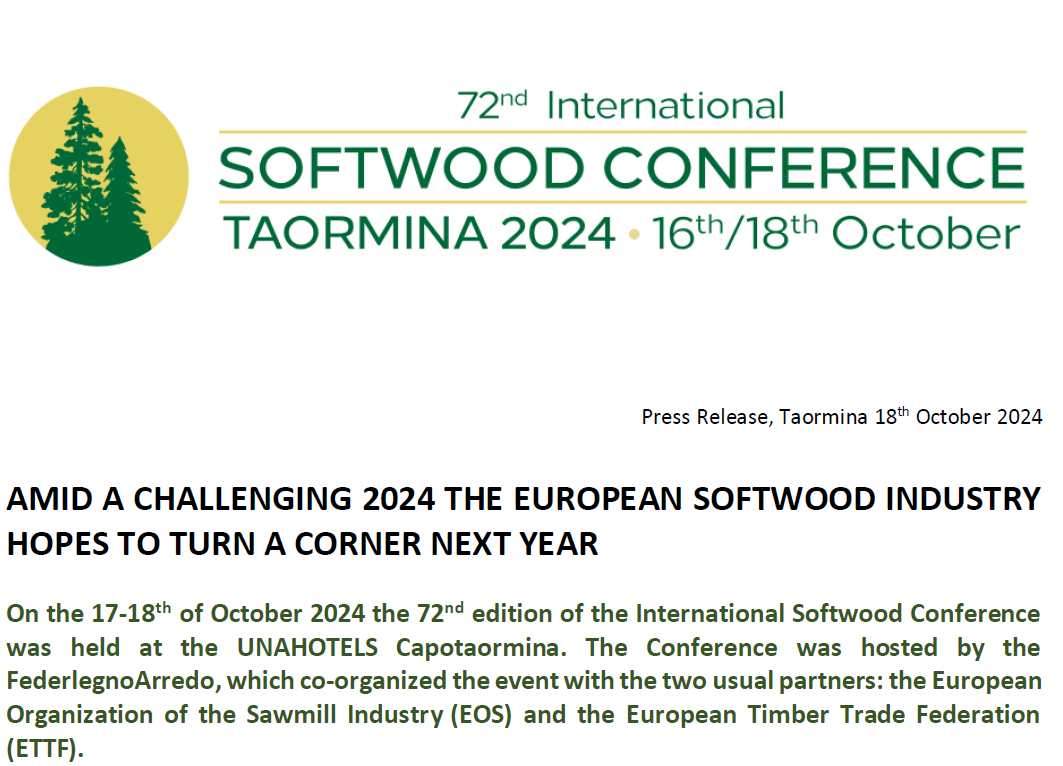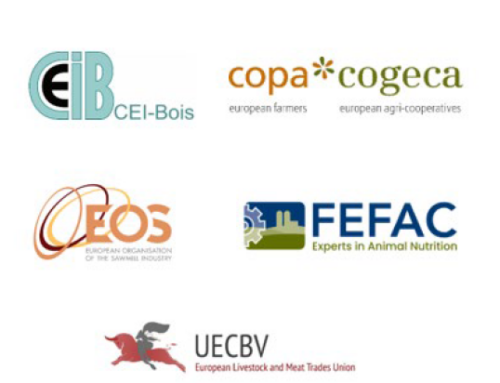
PRESS RELEASE International Softwood Conference
Taormina (Italy), 18th October – The event drew many participants as around 230 people – coming from over 20 countries all over the world – attended the conference. The event was opened by a macroeconomic overview provided by Marco Fortis, which showed that many factors, including geopolitical tensions and a slowdown of globalization, are having a negative impact on the global and European economy. Italy is a partial exception to this having done comparatively better than its European neighbours over the last couple of years.
During the first day of the Conference, information-packed sessions about the market trends were followed with attention by the audience. This year’s conference was marked by its truly global flair with presenters focusing not just on European markets, but on North America, China, Japan, MENA, India, Australia and New Zealand. While there were regional differences, in some cases significant, it is apparent that 2024 has been overall a challenging year for the softwood industry across the world – but probably slightly better than expected at the end of 2023. The big question mark for operators in the sector is whether the market has bottomed out and 2025 can really be the year of recovery.
After peaking in 2021, softwood production has significantly fallen over the last few years to adjust to the demand decline. If forecasts for 2024 are confirmed, at the end of the year production will be 12% lower than in 2021. Next year production is expected to grow by 2-3%.
Morten Bergsten, Vice-President and Softwood Chairman of ETTF, and Herbert Jöbstl, President of EOS, delivered similar messages in their presentations from their respective vantage points of user and producer. Production in the sector has been curtailed to accommodate weak demand. Sawn softwood prices have sharply declined from the peaks observed during 2021 and 2022. This is mainly due to the downfall of the construction sector. However, there might be light at the end of the tunnel. As it was reported by numerous speakers at the Conference interest rates have started falling across the world, which might trigger an upturn in the construction sector, which would be vital for sawmillers and traders alike. If the market does have already bottomed out, the recovery is expected to be sluggish at least in the short-term.
One element that was singled out not just by the European presentations but also by Canadian presenters is the availability and affordability of raw materials.
Mr Jöbstl in particular showed that the availability of raw materials has reached record low levels across Europe. At the same time, logs prices have reached record high levels in the Nordic countries, which is denting profitability of the sector. This happened in a low-demand environment. When demand resumes, there is a risk of logs prices being structurally too high. The industry is thus called to explore any possible solution to increase efficiency, including a further increase of log yield, automation, AI solutions etc.
When it comes to trade, Mr Bergsten forcefully emphasized that EU sanctions on the Russian and Belarusian wood products should be respected by all players in the woodworking industry, which strongly condemns the residual imports of such products via third countries. Governments across Europe are invited to fully enforce these sanctions and make sure loopholes are avoided.
European and North American presenters alike stressed that costs have shot up remarkably over the last few years. While inflation is now cooling down, the new, higher cost structure remains, which is a further reason why boosting efficiency for the industry is even more important. Production will structurally decline in British Columbia and in the US West, while demographic tailwinds across North America point to a favourable demand outlook over the next few years. This leaves opportunities for European exporters to keep playing an important role in parts of North America.
Presenters showed that other markets, with the partial exception of Japan, have seen their imports shrink in 2024 amid several local challenges (instability in the Middle East, housing market crisis in China). A presentation on the Indian market persuasively argued the long-term potential of India as an importer of European sawn softwood.
The second day of the Conference included three different panel discussions regarding issues of interests to both traders and sawmillers. The first panel discussion saw interesting exchanges on the wider role that forests will play in the future. Panellists stressed that long-term projections concur in predicting an increasing demand for roundwood as wood-based products will be an important part of the efforts to decarbonize the European economy. At the same time, there might be challenges in meeting this demand as the supply of wood from forests is not expected to grow considerably due to a number of factors including forests disturbances and political decisions.
The second panel discussion was about the building sector, in particular the commercial relationship between Austria and Italy. While the overall construction market is not doing well, wood as a building material has achieved a good market share in some European countries over the last few years. During the panel inspiring wooden buildings projects were presented. The potential of wood products in decarbonizing the built environment were stressed by panellists as well as its many other qualities which make wood an attractive material to build. Challenges remain when it comes to scaling up solutions and further mainstreaming the know-how on how to build with wood.
Last but not least, the third panel discussion consisted in a thorough assessment of the EU Deforestation Regulation in the light of recent political developments. The exchanges of view focused on the challenges that nevertheless remain despite the announcement of a possible one-year delay (pending approval of the EU Parliament). Despite the publication of guidelines for the application of the EUDR, uncertainties are still present and feasible solutions shall be found having in mind the complexity of integrated supply chains such as the wood-furniture sector.
Forest owners, traders, wood and furniture industries are closely working together and in consultation with the relevant national competent authorities to enable the application of such an ambitious Regulation.
The next edition of the International Softwood conference will take place in Oslo, Norway on 22/24 October 2025. More information will follow in due course. For more information on the 2024 edition, please visit the website https://www.iscevent2024.com.
Related Posts
Contact
EUROPEAN ORGANISATION
OF THE SAWMILL INDUSTRY AISBL
Rue Montoyer 24/box 20
BE-1000 Brussels
Tel.: +32 2 287 08 68
Email: info@eos-oes.eu




